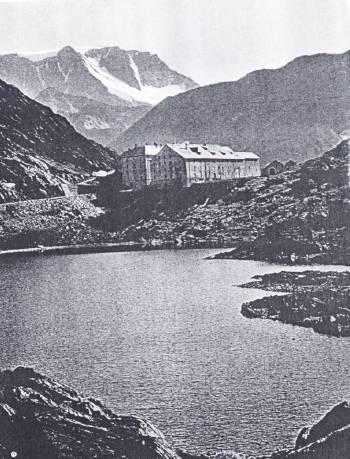![]()

![]()

A hospice of a very different kind to the one which gives such a very warm welcome to travellers at Walsingham, is that of the Hospice of the Augustinian Monks, of the Great St. Bernard Pass, in Switzerland.
To the winter traveller, the prospect of crossing the Alps by the Grand Pass of St. Bernard's, is a daunting one, were it not for the hospice which St. Bernard founded over one thousand years ago. The summit of the Pass is 8,100 feet above sea level, just on the fringe of the zone which, at 9,000 ft, snow never melts. Few would dare to venture to make the journey for 8 or 9 months in the year, which is often the length of the winter.
The work of the Augustinian monks at the Hospice, as of that at Walsingham, is to give shelter to travellers - with, of course, one big difference. For the band of devoted and devout monks are aided by one of our oldest friends - The Dog. In the never-ending struggle in these remote regions with the often devastating forces of Nature, it is unthinkable that the loyal and trusty St. Bernard dog will ever be discarded by the Brothers.
The massive, shaggy, long coated St. Bernard dogs, with their happy and affectionate natures, are loved and known the world over, but to the monks, when a lone traveller is reported to them as missing, they are known as an essential part of a rescue team, with the small barrels of brandy around the dog's neck. In mid-winter, the cold is so great at these heights on the Pass, that the snow around seems to offer an inviting and comparatively warm couch to the weary traveller, who then sits down for a rest, becomes drowsy, and falls asleep. He is fortunate indeed to be found and wakened by the dogs of the Hospice.
These famous dogs have saved many lives, often being taken out by one of the monks, in deep snow and raging blizzards, to find, and reach, people overtaken in the Pass by a storm. A person will be buried in twenty feet of deep snow, yet the dogs will find them, whether alive or perhaps sadly, dead. The St. Bernard dog is trained to bark, and to allow the injured person to take the brandy flask from its collar. The monks, on hearing the barking, will follow its direction and with courage and indomitable perseverance, will eventually arrive back at the hospice at the Monastery, in this lonely, beautiful place.
It is a never-ending battle against snow, ice, blizzards and avalanche. The monks wear skis to prevent them from sinking in the snow, but the great dogs will often sink very deep, and the work is full of danger to both dogs and monks; play is an essential part of the dogs' routine back at the hospice, however, and the mountains and Monastery ring with their barking as they rush around pouncing on each other; sometimes they will suddenly spring out on a monk or guest and send them down headlong, but it is all in good fun, of course. They have their ill-health as well, at times. Rheumatism from exposure is their main ailment.
The dog's chief characteristic is immense strength and when young as puppies, will often not let the monks put a collar on them. They will pull these heavy collars away with their paws, and stand over them, showing their teeth and daring anyone to approach. When the Brother does tackle the disobedient puppy, it will romp about and often drag him around. In time they learn to behave as they should do.
The work is very hard for a dog, especially as they have to wear the large collars with the brandy barrels slung around their necks. Their big frame, full thick coats and benevolent expression is surely everyone's idea of these animals. With their kindly friendly dispositions they have endeared themselves to all. We can say that they have indeed evolved originally from their caring Augustinian monks; and we are so grateful to them for this wonderful legacy - their faithful, loyal, hard-working companions in vital rescue work - The St Bernard Dog.
written by Rosemary Goulding
![]() Return to the Summer 1999 Features page
Return to the Summer 1999 Features page
![]() return to Home page and main index
return to Home page and main index
page last updated 1 JULY 1999